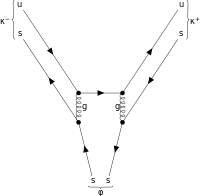OZI rule


The OZI rule is a consequence of quantum chromodynamics (QCD), that explains why certain decay modes appear less frequently than otherwise might be expected. It was independently proposed by Susumu Okubo, George Zweig and Jugoro Iizuka in the 1960s.[1] [2] [3] It states that any strongly occurring process will be suppressed if its Feynman diagram can be split in two by cutting only internal gluon lines.
An example of such a suppressed decay is φ → π+ + π− + π0. It would be expected that this decay mode would dominate over other decay modes such as φ → K+ + K−, which have much lower Q values. In actuality, it is seen that φ decays to kaons 84% of the time, suggesting the decay path to pions is suppressed.
An explanation of the OZI rule can be seen from the decrease of the coupling constant in QCD with increasing energy (or momentum transfer). For the OZI suppressed channels, the gluons must have high q2 (at least as much as the rest mass energies of the quarks into which they decay) and so the coupling constant will appear small to these gluons.
A further example is given by the decays of excited states of charmonium (bound state of charm quark and antiquark). For states lighter than the charged D mesons, the decay must proceed just like the above example into three pions, with three virtual gluons mediating the interaction, each of which must have enough energy to produce a quark-antiquark pair. But above the D meson threshold, the original valence quarks need not annihilate; they can propagate into the final states. In this case, only two gluons are required, which share the energy of the light quark-antiquark pair that is spontaneously nucleated. They are thus lower in energy than the three gluons of the OZI-suppressed annihilation. The suppression arises from both the smaller values of the QCD coupling constant at high energies, as well as the greater number of interaction vertices.
See also
Notes
- ↑ S. Okubo, Phys. Lett. 5, 1975 (1963).
- ↑ G. Zweig, CERN Report No.8419/TH412 (1964).
- ↑ J. Iizuka, Prog. Theor. Phys. Suppl. 37, 38 (1966).
References
- B.R. Martin, G. Shaw; "Particle physics", John Wiley & Sons, Chichester (England) 2nd ed. (1997), Chapt. 6.1.1 Charmonium – p. 128. ISBN 0-471-92358-3
- D. Griffiths, "Introduction to Elementary Particles", Wiley-VCH (Germany) 2nd ed. (2008), chapter 5.4.1. ISBN 978-3-527-40601-2